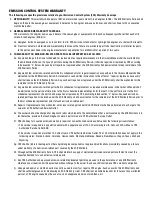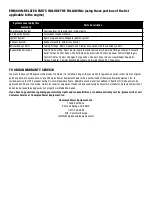
100455 - 2000W PORTABLE INVERTER GENERATOR
STORAGE
20
STORAGE
!
DANGER
Gasoline and gasoline vapors are highly flammable and
extremely explosive.
Fire or explosion can cause severe burns or death. Only
fill or drain fuel outdoors in a well-ventilated area. DO NOT
pump gasoline directly into the generator. Use an approved
container to transfer the fuel to the generator. Never use
a gasoline container, gasoline tank, or any other fuel item
that is damaged or appears damaged. DO NOT overfill the
gasoline tank. Always keep fuel away from sparks, open
flames, pilot lights, heat and other sources of ignition.
DO NOT light or smoke cigarettes.
Short Term Storage (up to 1 year)
Gasoline in the gasoline tank has a maximum shelf life of up to
1 year with the addition of properly formulated fuel stabilizers
and if stored in a cool, dry place. Gasoline in the carburetor,
however, may gum up and clog the carburetor if it isn’t used or
drained within 2-4 weeks.
1. Be sure all appliances are disconnected from the generator.
2. Add a properly formulated fuel stabilizer to the gasoline
tank.
3. Turn the fuel valve to the “ON” position.
4. Start and run the generator for 10 minutes so the treated
gasoline cycles through the fuel system and carburetor.
5. Turn engine switch to the “OFF” position and allow
generator to cool completely before continuing.
6.
Option 1: Drain Gasoline from Carburetor
6a. Turn the fuel valve to the “OFF”.
6b. Use the drain bolt on the carburetor to empty any
excess gasoline from the carburetor into an appropriate
container. Use a funnel (and appropriate hose if
necessary) under the carburetor drain bolt to avoid
spillage.
6c. When gasoline stops flowing from the carburetor,
replace and tighten the carburetor drain bolt and
be sure to properly dispose of the drained gasoline
according to local regulations or guidelines.
7.
Option 2: Run Dry
7a. Turn engine switch to the “ON” position and start the
generator.
7b. With the generator running, turn the fuel valve to the
“OFF” position and allow the generator to run until the
engine stops from complete fuel starvation. This may
take a few minutes.
7c. Turn engine switch to the “OFF” position and allow
generator to cool completely before continuing.
8. Remove the spark plug cap and spark plug and pour about
a tablespoon of oil into the cylinder.
9. Pull the recoil slowly to crank the engine to distribute the
oil and lubricate the cylinder.
10. Reattach the spark plug and spark plug cap.
11. Clean the generator according to
Cleaning the Generator
.
12. Store the generator in a cool, dry place out of direct
sunlight.
Long Term Storage (more than 1 year)
For storage over 1 year, the gasoline tank and carburetor must
be completely drained of gasoline.
1. Follow steps 1-5 according to
Short Term Storage
.
2. Use the drain bolt on the carburetor to empty any excess
gasoline from the gasoline tank and carburetor into an
appropriate container. Use a funnel (and appropriate hose if
necessary) under the carburetor drain bolt to avoid spillage.
3. When gasoline stops flowing from the carburetor, replace
and tighten the carburetor drain bolt and be sure to
properly dispose of the drained gasoline according to local
regulations or guidelines.
4. Turn the fuel valve to the “OFF” position.
5. Follow steps 8-12 according to
Short Term Storage
.
Removing from Storage
If the generator has been improperly stored for a long period
of time with gasoline in the gasoline tank and/or carburetor, all
fuel must be drained and the carburetor must be thoroughly
cleaned. This process involves technically advanced tasks.
For assistance please call our Technical Support Team at
1-877-338-0999.














































